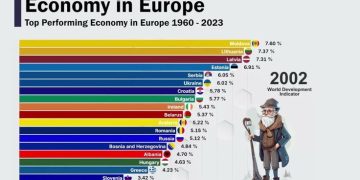**Europe’s Banking System Under Pressure:
Stability, Fragmentation, and the Search for a Unified Financial Architecture**
1. Introduction: A Quiet System Facing Loud Risks
Europe’s banking system has rarely been more paradoxical than it is today. On the surface, the continent’s banks appear stable: capital ratios are higher than pre-2008 levels, liquidity buffers are thick, and supervisory frameworks have been strengthened significantly. But beneath this veneer of stability lies a web of structural weaknesses:
- A fragmented banking landscape
- Persistent profitability challenges
- High exposure to sovereign debt
- Slow digital transformation compared to the U.S. and Asia
- Dependence on the European Central Bank (ECB) for liquidity
- Rising credit risks as interest rates remain high
- Vulnerability to geopolitical and energy shocks
European banks operate in a system that is robust in regulation yet fragile in competitiveness. Compared with the United States—where a unified capital market, large national banks, and strong tech-driven financial innovation dominate—Europe’s financial structure remains siloed along national lines. This creates inefficiencies that the European Union has spent decades trying to overcome.
This article examines the key pressures affecting the European banking sector today, the structural forces shaping its evolution, and the ongoing debate over the creation of a unified banking and capital markets architecture.
2. Europe’s Banking Landscape: Fragmented and Uneven
2.1 A Banking Union That is Not Yet a Union
Europe’s Banking Union was launched in 2012 with three pillars:
- Single Supervisory Mechanism (SSM) – ECB-led supervision
- Single Resolution Mechanism (SRM) – coordinated bank resolution
- European Deposit Insurance Scheme (EDIS) – proposed but never implemented
Only the first two exist in functional form. The absence of EDIS means:
- Deposits are still guaranteed at the national level
- Cross-border bank mergers are limited
- Banks remain more “national” than “European”
- Financial stability still depends on the strength of individual member states
This incomplete architecture leaves Europe vulnerable during crises.
2.2 North-South Banking Divide
A persistent divide exists between Northern European banks (Germany, Netherlands, Scandinavia) and Southern banks (Italy, Spain, Greece, Portugal):
- Northern banks tend to have stronger balance sheets but lower profitability.
- Southern banks often show higher profitability but weaker asset quality and lower capital buffers.
This divergence complicates policymaking and slows progress toward banking integration.
2.3 The Role of State Ownership
In several EU countries—France, Germany, Italy, and much of Eastern Europe—state-owned or state-supported banks remain significantly influential. While they enhance stability, they also:
- Reduce competitive pressure
- Limit consolidation opportunities
- Distort lending incentives
- Create political influence over credit flows
This political dimension complicates efforts to unify the banking market.
3. The Profitability Problem: Europe’s Long-Standing Weakness
3.1 Structural Low Profitability
European banks have underperformed global peers for over two decades. Compared to U.S. banks:
- Return on equity (ROE) is consistently lower
- Cost-to-income ratios are significantly higher
- Investment banking revenue is declining
- Capital markets activities are shrinking
Europe’s banking sector is simply not as profitable, and this persistent weakness makes banks less able to invest in innovation, take risks, or expand internationally.
3.2 Overbanking: Too Many Banks, Too Little Scale
Europe has more banks per capita than almost any region in the world. Many of these institutions are:
- Small
- Regionally focused
- Under-digitalized
- Locked into legacy cost structures
Without consolidation, Europe cannot develop banks with the scale needed to compete globally.
3.3 High Operating Costs from Regulation and Fragmentation
Regulatory compliance consumes a large share of European banks’ operating budgets. Fragmentation worsens this:
- Multiple national regulators
- Country-specific tax systems
- Varying deposit insurance schemes
- Inconsistent insolvency laws
This regulatory complexity creates operational frictions that U.S. and Chinese banks simply do not face.
4. Rising Financial Risks: A System Entering a New Stress Cycle
4.1 Interest Rate Risks After Years of Low Rates
For a decade, European banks operated in a zero- or negative-rate environment. When rates surged after 2022, risks emerged:
- Bond portfolios suffered unrealized losses
- Duration mismatches widened
- The cost of new funding increased
- Mortgage markets began to slow sharply
While banks benefited from higher net interest margins (NIM), the strategic risks outweigh the short-term gains.
4.2 Credit Risks Growing Across the Continent
Slowing economic growth combined with tight financial conditions has increased credit risks across:
- Real estate markets
- Small and medium enterprises (SMEs)
- Commercial property sectors
- Energy-intensive industries
- Highly leveraged households
Germany’s real estate sector, once seen as stable, is now facing:
- Falling property prices
- Developer bankruptcies
- A decline in new construction
- Stress on commercial landlords
This is a slow-burning problem for banks heavily exposed to mortgage lending.
4.3 Sovereign-Bank Doom Loop: Still a Threat
Banks in Italy, Spain, France, and Portugal hold large quantities of domestic government bonds. This creates the risk of a feedback loop:
- Weak governments strain banks
- Weak banks strain governments
Despite regulatory reforms, the sovereign-bank nexus remains one of Europe’s greatest systemic vulnerabilities.

5. Digital Transformation: Europe Falling Behind
5.1 Slow Adoption of Fintech Innovation
While the EU has ambitious digital agendas, its banking sector lags behind:
- U.S. banks integrate AI and automation faster
- Chinese banks lead in mobile payments and financial ecosystems
- European banks often struggle with legacy IT systems
The digital gap is widening.
5.2 PSD2 and Open Banking: Ambition Without Scale
Europe’s open banking framework (PSD2) intended to spark financial innovation. Instead:
- Implementation is uneven
- Major banks have resisted integration
- Consumer adoption remains modest
- Tech ecosystems lack scale compared to Silicon Valley or Shenzhen
The regulatory innovation did not translate into market transformation.
5.3 Crypto and Digital Assets: A Conservative Region
The EU’s MiCA regulation establishes a clear framework for digital assets, but:
- Adoption among banks is cautious
- Crypto services are limited
- Tokenization is in early stages
Europe risks missing the next era of financial innovation if it cannot accelerate digital adoption.
6. EU Capital Markets: Fragmented and Underdeveloped
6.1 Europe’s Reliance on Banks for Corporate Finance
Unlike the United States, where capital markets dominate, Europe relies heavily on banks for corporate lending:
- Corporate bond markets are smaller
- Venture capital is less developed
- Equity markets are fragmented
- IPOs are rare compared to the U.S. or China
This overdependence on banks strains the system during crises.
6.2 The Long-Stalled Capital Markets Union (CMU)
The EU launched CMU in 2015, aiming to:
- Harmonize financial regulations
- Increase cross-border investment
- Deepen European capital markets
Progress has been slow because:
- Countries resist ceding control over insolvency laws
- Tax regimes vary widely
- National regulators protect domestic markets
Without CMU, Europe cannot compete with global capital market hubs.
7. The ECB: The Systemic Backstop
7.1 The ECB as Lender, Supervisor, and Stabilizer
The ECB’s role has grown enormously:
- Supervises major banks
- Stabilizes sovereign bond markets
- Provides liquidity through TLTROs
- Manages the Anti-Fragmentation Instrument
- Influences credit creation through policy rates
This centralization is both stabilizing and risky.
7.2 Dependence on the ECB
European banks rely on ECB liquidity more than U.S. banks rely on the Federal Reserve. This:
- Distorts credit allocation
- Creates moral hazard
- Undermines market discipline
Exiting from ECB support will be extremely difficult.
8. Banking Consolidation: The Long-Delayed Transformation
8.1 Why Europe Needs Consolidation
Consolidation could:
- Improve competitiveness
- Reduce overbanking
- Increase efficiency
- Build pan-European financial champions
- Enable banks to scale technology investments
But major obstacles remain.
8.2 Political Resistance
Governments resist cross-border takeovers:
- Fear of losing national control
- Protection of domestic champions
- Concerns over deposit insurance harmonization
As long as EDIS is not completed, consolidation will remain limited.
9. The Road to a Unified European Financial Architecture
9.1 Completing the Banking Union
The EU must implement:
- A common deposit insurance scheme
- Harmonized insolvency rules
- Cross-border resolution tools
- A unified crisis backstop
Without these, the Banking Union will remain incomplete.
9.2 Completing the Capital Markets Union
Europe must:
- Harmonize tax structures
- Improve IPO markets
- Support venture capital
- Attract institutional investors
- Promote securitization markets
A deeper capital market is essential for financing the energy transition and digital transformation.
10. Conclusion: Stability Without Strength
Europe’s banking system is stable—perhaps more stable than at any time in recent history. But stability does not equal strength. The system remains:
- Fragmented
- Under-scaled
- Dependent on the ECB
- Technologically behind global competitors
- Exposed to sovereign and credit risks
- Constrained by political fragmentation
The greatest danger for Europe is complacency. If structural reforms continue at a slow pace, Europe’s financial system risks becoming globally irrelevant—even if it remains domestically stable.
































